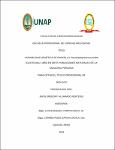Variabilidad genética de doncella Pseudoplatystoma punctifer (Castelnau, 1855) en siete poblaciones naturales de la amazonía peruana
Abstract
This study aimed to determine the genetic variability of 203 specimens of doncella Pseudoplatystoma punctifer from seven natural populations of the Peruvian Amazon through the analysis of 8 microsatellite loci. The results show a high genetic variability in the species (113 alleles found, with an average of 13.14 alleles per locus). The correspondence factor analysis showed the existence of genetic differentiation between some populations of this species, in addition, the results of the fixation index (FST), Number of migrants per generation (Nm) and genetic distance showed that the populations of Madre de Dios and Nanay present the greatest genetic differences between them (FST = 0.115, Nm = 1.93; D = 0.349) and also with the rest of the populations (Madre de Dios: FST varies from = 0.039 to 0.057; Nm = 4.16 to 6.24; D = 0.135 to 0.174; Nanay: FST varies from = 0.060 to 0.080, Nm = 2. 88 to 3.95; D = 0.165 to 0.222). It was also observed that the populations of the Marañon and Ucayali rivers do not show genetic structuring between them (FST = 0.00; Nm = infinity; D = 0.003). The results of the genetic structuring analysis corroborated these results, showing three evolutionary units among the seven populations analyzed (K = 3). The differences found among these fish populations could be related to isolation by geographic distance in the case of Madre de Dios or isolation by the difference in the type of water in the case of Nanay. Este estudio tuvo como objetivo determinar la variabilidad genética de 203 especímenes de doncella Pseudoplatystoma punctifer de siete poblaciones naturales de la Amazonia peruana mediante el análisis de 8 loci microsatélites. Los resultados muestran una alta variabilidad genética en la especie (113 alelos encontrados, con una media de 13,14 alelos por locus). El análisis factorial de correspondencia mostró la existencia de diferenciación genética entre algunas poblaciones de esta especie, además, los resultados del índice de fijación (FST), Número de migrantes por generación (Nm) y distancia genética mostraron que las poblaciones de Madre de Dios y Nanay presentan las mayores diferencias genéticas entre ellas (FST = 0,115, Nm = 1,93; D = 0,349) y también con el resto de poblaciones (Madre de Dios: FST varia de = 0,039 a 0,057; Nm = 4,16 a 6,24; D = 0,135 a 0,174; Nanay: FST varia de = 0,060 a 0,080, Nm = 2.88 a 3,95; D = 0,165 a 0,222). Además fue observado que las poblaciones de los ríos Marañón y Ucayali no presentan estructuración genética entre ellas (FST = 0,00; Nm = infinito; D = 0,003). Los resultados del análisis de estructuración genética corroboraron estos resultados, mostrando tres unidades evolutivas entre las siete poblaciones analizadas (K = 3). Las diferenciaciones encontradas entre estas poblaciones de peces podrían estar relacionadas al aislamiento por distancia geográfica en el caso de Madre de Dios o al aislamiento por la diferencia en el tipo de agua en el caso del Nanay.
Collections
- Tesis [419]


